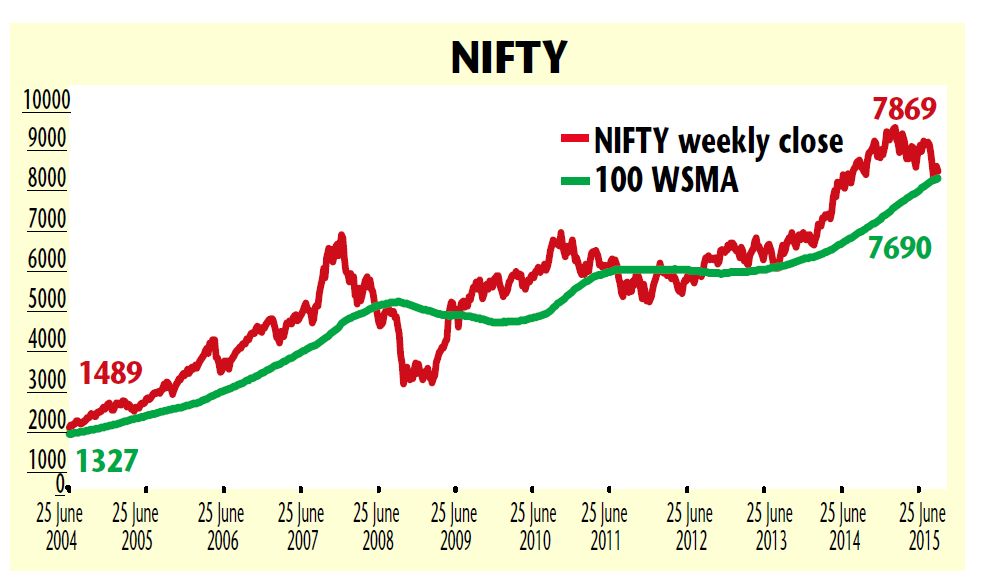
NIFTY’s 100 WSMA of 7690 should act as strong support for the markets
Moving averages are one of the most commonly used tools in technical analysis. Analysts across the globe use different variations of moving averages across different number of time periods. These moving averages not only help in defining market trends, but also help in figuring out change in trends. It also helps determine major supports and resistance levels.
Moving averages can be calculated on daily or weekly values, depending on investors’ objective. Investors use shorter duration moving averages such as 5-DMA, 14-DMA, 26-DMA, 50-DMA, etc, for tracking short-term trends and 100-DMA, 150-DMA, 200-DMA, as also 100 week moving average (WMA) and 200 WMA for monitoring long term trends. On 24 September 2015, Nifty closed at 7869 levels, just a couple of hundred points away from 100-week simple moving average of 7690.
The ongoing uncertainty in the global markets is keeping investors at bay. China-led global slowdown and the uncertainty over impending interest rate hike in the US has kept investors guessing on the clear direction of the markets.
There is risk-off happening globally, with FIIs selling riskier assets such as equities. Since 10 August 2015, when China announced devaluation of its currency, FIIs have sold over Rs29,000 crore worth of Indian equities. Nifty, which corrected by 11.7 per cent between 7 August and 7 September 2015, has bounced back by 5.5 per cent during 7-21 September, but volumes are falling. Despite the recent recovery, investors are shying away from the equities.
During this entire correction, equity mutual funds have consistently bought equities. As per AMFI data, equity mutual funds have invested over Rs11,000 crore in equities in August 2015. DIIs have collectively invested over Rs25,000 crore between 10 August and 23 September 2015.
Globally, emerging markets dependent on commodities are struggling to manage their finances, as commodity prices have remained weak. Brent crude is now trading at $48 per barrel. Base metal prices too have fallen due to weak demand. Experts expect commodity prices to continue to remain weak for an extended period.
The sharp fall in commodities has come as a blessing in disguise for India, as its economy is primarily dependent on imported crude. This has helped India lower inflation and control ballooning deficit. India’s CPI inflation fell to 3.66 per cent in August 2015. WPI inflation too fell to -4.95 per cent, the 10th consecutive month of negative inflation. This trend should encourage RBI to lower interest rates.
The government has its focus on long-term growth plans. It has cut down subsidies and reduced wasteful expenditure. It has announced various measures to encourage investments in infrastructure projects to revive demand. As demand recovers and interest rates fall, India will see strong revival of the capex cycle, driving full-fledged economic recovery.
Fall in commodity prices has already started reflecting in the financials of the corporate sector, in the form of higher gross margins. Revival in revenue growth, coupled with falling interest rates, will drive growth.
After the recent correction, markets are now quoting at reasonable P/E multiples of mid-teens – lower than the historical long-term average. Despite global uncertainties, India is relatively on a firm footing.
On the downside, India is facing the risk of a second consecutive year of below-normal monsoon, which could adversely impact rural demand and re-ignite inflationary pressure in the economy. There is also too much uncertainty in the global markets. These factors may temporarily deter RBI from aggressively cutting interest rates in the near term. In such a scenario, it is unfair to expect outperformance in Indian markets in the near term. However, once this turbulence subsides, India will once again resume its long-term structural bull run. In the short term, Nifty should take support around its 100-week moving average, which currently stands around 7690.
This article was originally published in Business India Magazine.
Write to us at news@valuelineadvisors.com
Disclaimer: The views expressed in this article are personal and the author is not responsible in any manner for the use which might be made of the above information. None of the contents make any recommendation to buy, sell or hold any security and should not be construed as offering investment advice.
